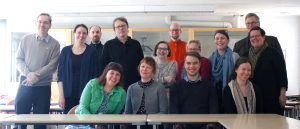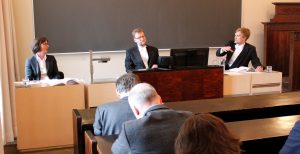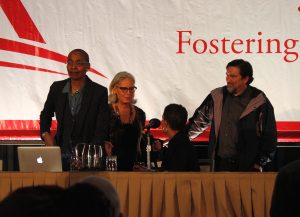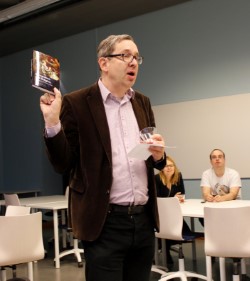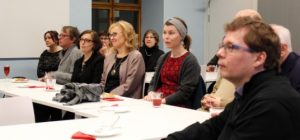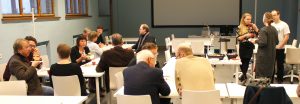Ingressi:
Mikä on antroposeeni ja miten se liittyy uskonnontutkimukseen? Huippuyksikön jäsen Panu Pihkala valottaa teemaa amerikkalaisen tutkimushankkeen kautta.
Being Human in the Age of Humans –tutkimusprojekti on yhdysvaltalainen korkean tason hanke, jossa tarkastellaan niin kutsuttua antroposeenia uskontojen ja etiikan näkökulmista. Minulla oli kunnia tulla vuonna 2017 valituksi projektin osahankkeeseen, jossa pieni osallistujajoukko kokoontui kaksi kertaa hiomaan tutkimusnäkökulmiaan. Ainoana eurooppalaisena osallistujana päädyin usein keskustelemaan kulttuurieroista.
Toukokuussa 2018 projekti järjesti mittavan konferenssiin Indianan yliopistossa Bloomingtonissa. Pääjärjestäjä, professori Lisa Sideris, on pitkään harjoittanut ympäristöetiikan ja uskonnollisen etiikan tutkimusta. Muita johtohahmoja ovat teologian ja luonnontieteiden eräs johtava tutkija Celia Deane-Drummond, postkolonialistisen uskonnontutkimuksen asiantuntija Kyle Powys Whyte ja Chicagon yliopiston apulaisprofessori Sarah Fredericks. Viimeksimainittu valmistelee kirjaa syyllisyydestä ja häpeästä ympäristöasioiden suhteen, mikä luo yhteyksiä omaan tutkimukseeni ympäristökriisin psykologisista ja hengellisistä vaikutuksista.
Konferenssin tarkka ohjelma löytyy sen internetsivuilta (Being Human in the Age of Humans). Tässä tekstissä nostan esiin eräitä pääteemoja ja esittelen lyhyesti antroposeeni-käsitteeseen liittyvää keskustelua.
Mikä antroposeeni?
Antroposeeni on nopeasti yleistynyt käsite, jolla tarkoitetaan ”ihmisen aikakautta”. Taustalla ovat havainnot siitä, että ihmiskunta on vaikuttanut planeettaan hyvin merkittävästi. Monet ovat esittäneet, että kyse on uudesta geologisesta kaudesta: holoseeni olisi muuttunut antroposeeniksi.
Tämän konferenssin tutkijoista monet olivat hyvin kriittisiä antroposeeni-käsitettä kohtaan. Ihmisen tuottamia valtavia ympäristöongelmia kukaan ei kiistänyt, mutta itse termiä syytettiin epätarkkuudesta. Esimerkiksi pitkän linjan ympäristöeetikko Baird Callicott ehdotti esitelmässään, että ihmisen mittavien vaikutusten aika alkoi jo pleistoseenin aikana tapahtuneiden suurten eläinten laajojen sukupuuttojen myötä.
Konferenssin nimessä olikin ovelasti vältetty antroposeeni-sana ja käytetty ”ihmisen aika” (Age of Humans)-termiä. Esitettiin, että kyseessä ei ole ainakaan epookki, vaan aikakausi, aivan kuten käytetään termiä dinosaurusten aikakausi.
Kenen antroposeeni?
Antroposeeni-termin käyttöönottoa kritisoitiin myös erilaisin eettisin perustein. Kuka saa määritellä aikakausien nimet? Ja mitä kaikkea pitäisi ottaa huomioon sellaisessa prosessissa? Konferenssissa kuultiin paljon esitelmiä, joissa nostettiin esiin erilaisten vähemmistöjen näkökulmia.
Alkuperäiskansojen edustajat suhtautuvat sekä ilmastonmuutokseen että antroposeeni-käsitteeseen sangen eri tavoin kuin valkoihoiset länsimaiset teollisuusmaiden asukkaat. Alkuperäiskansojen näkökulmasta se, että tilanne on katastrofaalinen, ei ole mitään uutta. Kolonialismi ja erilainen muu sorto on jo pitkään johtanut heidän yhteisöjensä ja elinympäristöjensä vaurioitumiseen.
Kathryn Yusoff lähestyi antroposeeniin liittyvää selviytymis-teemaa (survival) vähemmistöjen näkökulmasta ja kyseenalaisti teeman universaaliuden. On paljon vähemmistöjen edustajia, joiden maailma on ikään kuin jo loppunut. He eivät odota nykyisen maailmanmenon selviytymistä vaan sen perinpohjaista muuttumista.
Rosalyn LaPier tarkasteli mustajalka-intiaanien luontokäsityksiä ja niiden suhdetta ilmastonmuutoksen aikaan. Usein oletetaan, että alkuperäiskansojen holistinen luontoajattelu tarjoaa olennaisia ratkaisuaineksia nykyiseen ympäristökriisiin. Onkin totta, että useimmat alkuperäiskansat ovat pystyneet huomattavasti kestävämpiin elämäntapoihin (ekosysteemien kantokyvyn suhteen) kuin teollistuneet yhteiskunnat. Kuitenkin esimerkiksi mustajalkojen uskomukset ovat aina pitäneet säätä sellaisena yliluonnollisena asiana, johon ihmiset eivät voi kovin paljon vaikuttaa. Lisäksi heidän taipumuksensa pitää näkymätöntä (henki)maailmaa todellisempana kuin fyysistä todellisuutta saattaa aiheuttaa epäkiinnostusta eräitä ympäristöasioita kohtaan.
Takaisin perusasioihin: ruoka ja kuolema
Yksi kansainvälisesti nouseva kulttuurin- ja uskonnontutkimuksen teema on ruoka. Taustalla on kasvanut kiinnostus kehollisiin käytäntöihin ja niiden kokonaisvaltaisiin piirteisiin. Uskonnontutkijat ovat havainneet, että myös uudet ruokailutottumukset saavat usein uskonnonkaltaisia ulottuvuuksia. Mainittakoon, että suomalainen Donner-instituutti oli Religion and Food -kesäkonferenssissaan vuonna 2014 aallonharjalla, ja itsekin esitelmöin ja kirjoitin ruoasta sekä ekoteologiasta tuolloin (Ecotheology and Theology of Eating).
Indianan konferenssissa ruokaa käsittelivät Gretel van Wieren ja Norman Wirzba, jotka molemmat ovat julkaisseet viime aikoina kokonaisen kirjan aiheesta. Van Wieren huomautti, että uskonnollisissa luomuviljely-yhteisöissä maatila saa eräänlaisen pyhän paikan statuksen. Wirzba tarkasteli syömistä soveltavan teologian näkökulmasta ja vertasi ruokasuhdetta parisuhteeseen. Hän näki eettisiä ongelmia siinä, että nykyihmisten ruokasuhde on usein kuin sellainen yhden yön suhde, jossa ei halutakaan tietää, mistä toinen tulee ja kuka toinen perimmältään on. Wirzba etsi kestävämpien elämäntapojen elementtejä syvemmästä sitoutumisesta ruoan kanssa seurusteluun.
Stefan Skrimshire tarkasteli vuorostaan sukupuuttojen ja kuoleman kohtaamisen teemoja. Hän kohdisti kriittisen katseen niihin tapoihin, joilla antroposeenin ympärille luoduissa narratiiveissa käsitellään massasukupuuttoja. Skrimshire, joka on aiemmin tutkinut eskatologisten näkemysten ja ympäristöajattelun suhdetta, perusteli kiinnostavalla tavalla uskonnontutkimuksen relevanssia näiden kysymysten suhteen. Uskontotieteellistä ja teologista asiantuntemusta tulisi hyödyntää rajallisuuden sekä luopumisen käsittelytapojen analyysissä.
Ympäristö ja tunteet
Skrimshiren tutkimus sisältää liittymäkohtia omaan tutkimustyöhöni esimerkiksi ympäristösurun ja kuolevaisuuden käsittelyn teemojen suhteen. Varsinaisesti kukaan muu uskonnontutkija ei kuitenkaan ole vielä keskittynyt ympäristöahdistuksen ilmiöön, joten tutkimukseni herätti paljon kiinnostusta. Esitelmässäni ja tulevassa artikkelissani tarkastelen ympäristöahdistusta eksistentiaalisena ahdistuksena. Vertaan niin sanottujen eksistentiaalisten teologien ja filosofien, etenkin Paul Tillichin, ajattelua nykyajan kontekstin kysymyksiin.
Niin sanottuihin affekteihin liittyvä uskonnontutkimus sinänsä vaikuttaa olevan nousussa kansainvälisesti. Eräät konferenssiesitelmät sivusivat esimerkiksi ympäristömelankolian teemaa, myös sorrettujen ihmisryhmien näkökulmasta. Konferenssi antoikin uusia virikkeitä tulevaan kansainväliseen yhteistyöhön aiheen tiimoilta.
Panu Pihkala, TT, Tutkijatohtori
Kirjoittaja on huippuyksikön omarahoitteinen jäsen, jonka tietokirja Päin helvettiä? Ympäristöahdistus ja toivo (Kirjapaja 2017) on herättänyt yhteiskunnallista keskustelua

